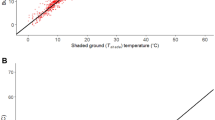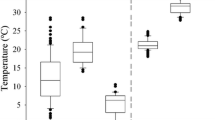Summary
We studied aspects of the thermal biology and microhabitat selection of the endangered lizard Podarcis hispanica atrata during autumn in the field and laboratory. Body temperatures (T b ) of active lizards were within a narrow range, were largely independent of ambient temperatures, and exhibited little diel variation. Activity T b s largely coincided with the selected temperatures maintained in a laboratory thermogradient and with T b s that maximize running performance. Alternation of basking with other activities and shuttling between sun and shade were obvious aspects of thermoregulatory behaviour. Lizards shifted microhabitat use throughout the day. During early morning and late afternoon, basking lizards were restricted to rocky sites surrounded by shrubs. Near midday lizards used a wider array of microhabitats, and many moved in open grassy sites. Juveniles maintained lower activity T b s, had lower selected temperatures, and basked less frequently than the adults. Juveniles occupied open grassy patches more often than the adults. We discuss the relevance of our results for the conservation of this extremely rare lizard and the management of its habitats.
Similar content being viewed by others
References
Adolph SC (1990) Influence of behavioral thermoregulation on microhabitat use by two Sceloporus lizards. Ecology 71: 315–327
Arnold EN (1973) Relationships of the palaearctic lizards assigned to the genera Lacerta, Algyroides and Psammodromus (Reptilia: Lacertidae). Bull Brit Mus (Nat Hist) Zool 25: 291–366
Avery RA (1982) Field studies of body temperatures and thermo-regulation. In: Gans C, Pough FH (eds) Biology of the Reptilia. Academic Press, London, pp 93–146
Avery RA (1984) Physiological aspects of lizard growth: the role of thermoregulation. Symp Zool Soc Lond 52: 407–424
Bakken GS, Gates GM (1975) Heat transfer analysis of animals: some implications for field ecology, physiology, and evolution. In: Gates DM, Schmerl RB (eds) Perspectives of biophysical ecology. Springer-Verlag, New York, pp 255–290
Boscá E (1916) Dos observaciones a propósito de la Lacerta muralis en España. Bol R Soc Espanola Hist Nat 16: 327–330
Brattstrom BH (1971) Critical thermal maxima of some Australian skinks. Copeia 1971: 554–557
Castilla AM, Jimenez J, Lacomba I (1987) Los reptiles de Columbretes. In: Alonso Matilla LA, Carretero JL, Garcia-Carrascosa AM (eds) Islas Columbretes. Contribución al estudio de su medio natural. Generalitat Valenciana, Valencia, pp 181–194
Christian KA, Tracy CR (1981) The effect of the thermal environment on the ability of hatchling Galapagos land iguanas to avoid predation during dispersal. Oecologia 49: 218–223
Christian K, Tracy CR, Porter WP (1983) Seasonal shifts in body temperature and use of microhabitats by Galapagos land iguanas (Conolophus pallidus). Ecology 64: 463–468
Corbett K (1989) The conservation of European reptiles and amphibians. Christopher Helm, London
Crawford KM, Spotila JR, Standora EA (1983) Operative environmental temperatures and basking behavior of the turtle Pseudemys scripta. Ecology 64: 989–999
Eisentraut M (1930) Beitrag zur Eidechsen der Pityusen und Columbreten. Mitt Zool Mus Berlin 16: 397–410
Gisbert JM (1987) Clima y suelo de las Islas Columbretes. In: Alonso Matilla LA, Carretero JL, Garcia-Carrascosa AM (eds) Islas Columbretes. Contribución al estudio de su medio natural. Generalitat Valenciana, Valencia, pp 95–107
Grant BW, Dunham AE (1988) Thermally imposed time constraints on the activity of the desert lizard Sceloporus merriami. Ecology 69: 167–176
Heath JE (1964) Reptilian thermoregulation: evaluation of field studies. Science 146: 784–785
Hertz PE, Huey RB, Garland T Jr (1988) Time budgets, thermoregulation, and maximal locomotor performance: are reptiles olympians or boy scouts? Am Zool 28: 927–940
Huey RB (1982) Temperature, physiology, and the ecology of reptiles. In: Gans C, Pough FH (eds) Biology of the Reptilia. Vol. 12. Academic Press, London, pp 25–91
Huey RB, Pianka ER (1977) Seasonal variation in thermoregulatory behavior and body temperature of diurnal Kalahari lizards. Ecology 58: 1066–1075
Huey RB, Slatkin M (1976) Cost and benefits of lizard thermoregulation. Quart Rev Biol 51: 363–384
Huey RB, Stevenson RD (1979) Integrating thermal physiology and ecology of ectotherms: a discussion of approaches. Am Zool 19: 357–366
Huey RB, Schneider W, Erie GL, Stevenson RD (1981) A fieldportable racetrack and timer for measuring acceleration and speed of small cursorial animals. Experientia 37: 1356–1357
Huey RB, Peterson CR, Arnold SJ, Porter WP (1989) Hot rocks and not-so-hot rocks: retreat-site selection by garter snakes and its thermal consequences. Ecology 70: 931–944
Klemmer K (1961) Las Islas Columbretes, die Schlangeninseln ohne Schlangen. Natur und Volk 91: 39–47
Licht P, Dawson WR, Shoemaker VH, Main AR (1966) Observations on the thermal relations of western Australian lizards. Copeia 1966: 97–111
Muth A (1977) Body temperatures and associated postures of the zebra-tailed lizard, Callisaurus dorsalis. Copeia 1977: 122–125
Paulissen MA (1988) Ontogenetic comparison of body temperature selection and thermal tolerance of Cnemidophorus sexlineatus. J Herpetol 22: 473–476
Pérez-Mellado V (1989) Estudio ecológico de la lagartija balear Podarcis lilfordi (Günther, 1874) en Menorca. Revista de Menorca 80: 455–511
Porter WP, James FC (1979) Behavioral implications of mechanistic ecology II: the African rainbow lizard, Agama agama. Copeia 1979: 594–619
Porter WP, Tracy CR (1983) Biophysical analyses of energetics, time-space utilization, and distributional limits. In: Huey RB, Pianka ER, Schoener TW (eds) Lizard ecology. Studies on a model organism. Harvard Univ Press, Cambridge, pp 55–83
Porter WP, Mitchell JW, Beckman WA, DeWitt CB (1973) Behavioral implications of mechanistic ecology. Thermal and behavioral modeling of desert ectotherms and their microenvironment. Oecologia 13: 1–54
Sinervo B, Adolph SC (1989) Thermal sensitivity of growth rate in hatchling Sceloporus lizards: environmental, behavioral and genetic aspects. Oecologia 78: 411–419
Stevenson RD (1985) Body size and limits to the daily range of body temperature in terrestrial ectotherms. Am Nat 125: 102–117
Van Berkum FH (1986) Evolutionary patterns of the thermal sensitivity of sprint speed in Anolis lizards. Evolution 40: 594–604
Van Damme R, Bauwens D, Verheyen RF (1986) Selected body temperatures in the lizard Lacerta vivipara: variation within and between populations. J therm Biol 11: 219–222
Van Damme R, Bauwens D, Verheyen RF (1987) Thermoregulatory responses to environmental seasonality by the lizard Lacerta vivipara. Herpetologica 43: 405–415
Waldschmidt S, Tracy CR (1983) Interactions between a lizard and its thermal environment: implications for sprint performance and space utilization in the lizard Uta stansburiana. Ecology 64: 476–484
Author information
Authors and Affiliations
Rights and permissions
About this article
Cite this article
Castilla, A.M., Bauwens, D. Thermal biology, microhabitat selection, and conservation of the insular lizard Podarcis hispanica atrata . Oecologia 85, 366–374 (1991). https://doi.org/10.1007/BF00320612
Received:
Accepted:
Issue Date:
DOI: https://doi.org/10.1007/BF00320612




